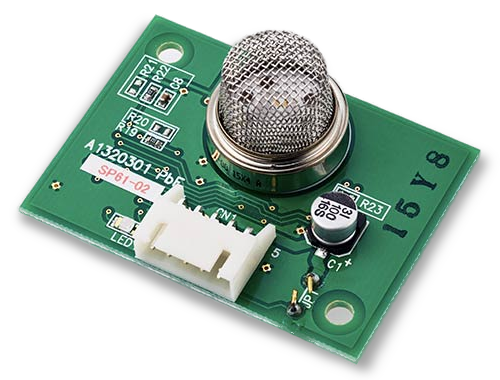Ozone Sterilization
Introduction of disinfection and sterilization technology,
which is gaining attention as an anti-virus measure
Ozone is a substance with a strong bactericidal effect that destroys microorganisms such as viruses and bacteria. Decontamination and disinfection by ozone is also used in sterilization work to prevent viral infections as an effective method with a low workload. This article provides an overview of sanitizing by ozone gas.
Ozone fumigation treatment
active in virus sanitization and disinfection
There are various methods for disinfection and sterilization of pathogenic microorganisms. Wipe cleaning with alcohol or hypochlorous acid is the most common. Although wiping is a highly reliable method, it is difficult to clean every inch of a room because it can only clean the wiped area.
Ozone fumigation is used to supplement the wipe-cleaning method. Ozone fumigation treats every inch of the room by releasing ozone gas, which has a high disinfection and sterilization capacity, into the room. It also destroys pathogenic microorganisms floating in the air, unlike wipe-down cleaning.
Sterilization work that combines ozone fumigation and wipe-cleaning with a disinfectant solution is also used as a countermeasure against viral infections.
Why ozone can sanitize a virus
Feature of Semiconductor Type gas sensor are its small size, Long Life, and Low Cost.
Gas Sensing Pro Shop
So how can ozone eliminate pathogenic microorganisms?
Ozone is a molecule with a structure consisting of three oxygen atoms bound together with a chemical formula O3. While oxygen molecules (O2) exist stably in the atmosphere, ozone (O3) is a very unstable substance. In nature, ozone (O3) is easily broken down into oxygen (O2), and at the same time it releases oxygen atoms (O) with strong oxidizing power. These oxygen atoms are known to be effective in killing and inactivating pathogenic microorganisms such as E. coli and influenza viruses. Ozone fumigation utilizes this effect.
Decontamination ability of ozone
(how long it needs to be fumigated)
The disinfection ability of ozone is expressed as the sum of the ozone concentration in the room and the fumigation time. This value is called CT value ( Concentration-Time Value ), and is used as an indicator of ozone disinfection effect.
CT value = ozone concentration (ppm) x fumigation time (min)
The appropriate CT value depends on the pathogen to be sterilized. For example, experiments have shown that E. coli and the new strains of influenza (H5N1) were killed almost 100% by ozone fumigation with a CT value of 60.
This means fumigating with a concentration of 1 ppm ozone for 60 minutes. Higher ozone concentrations are expected to shorten the work time, but care must be taken when increasing the ozone concentration. This is because high ozone concentration is harmful to the human body.
Effects of ozone on the human body
Because ozone decomposes easily in nature to harmless oxygen (O2), it does not remain in the room for long periods of time after fumigation. However, high concentrations of ozone are also harmful to the human body. The Society for Occupational Health has set the standard for ozone concentration in the working environment at 0.1 ppm or less. In addition, ozone concentrations above 0.5 ppm cause irritation of the airways, and at 1 ppm, headaches and chest pains are said to occur after about two hours of exposure. In other words, fumigation at a concentration of 1 ppm, as introduced in the previous chapter, is a process that uses high concentrations of ozone that can affect the human body. Such fumigation at such a high concentration of ozone must be carried out in an unmanned environment. When carrying out ozone fumigation, careful attention must be paid to the ozone concentration and human access to the fumigation process.
Effects of ozone on a new type of coronavirus (COVID-19)
Ozone fumigation has also been utilized in decontamination work for a new type of coronavirus (COVID-19). Experiments at medical institutions in Japan have shown that fumigation with high concentrations of 1 ppm to 6 ppm of ozone in a short period of time as well as prolonged release of 0.1 ppm or less of ozone, which has no effect on the human body, are effective in inactivating the new coronavirus.
These experiments have shown that ozone decontamination can be used in a variety of situations in the fight against a new type of coronavirus. For example, highly concentrated ozone can be used for effective sterilization in facilities that require high hygiene control, such as medical institutions. Low-concentration ozone fumigation could also be used as a supplement to the ventilation function in facilities where air replacement is difficult, such as restaurants, theaters, and public transportation facilities.
In this way, ozone disinfection is expected to contribute to the prevention of new coronavirus infections as well as to the revitalization of economic activities.
Product
An ozone sensor essential for the management of ozone concentration
To ensure effective and safe ozone fumigation, it is important to control the concentration of ozone, and Nissha FIS provides ozone sensors to help manage the safety of ozone fumigation and prevent the spread of viruses.
For more information, please see our product page.

